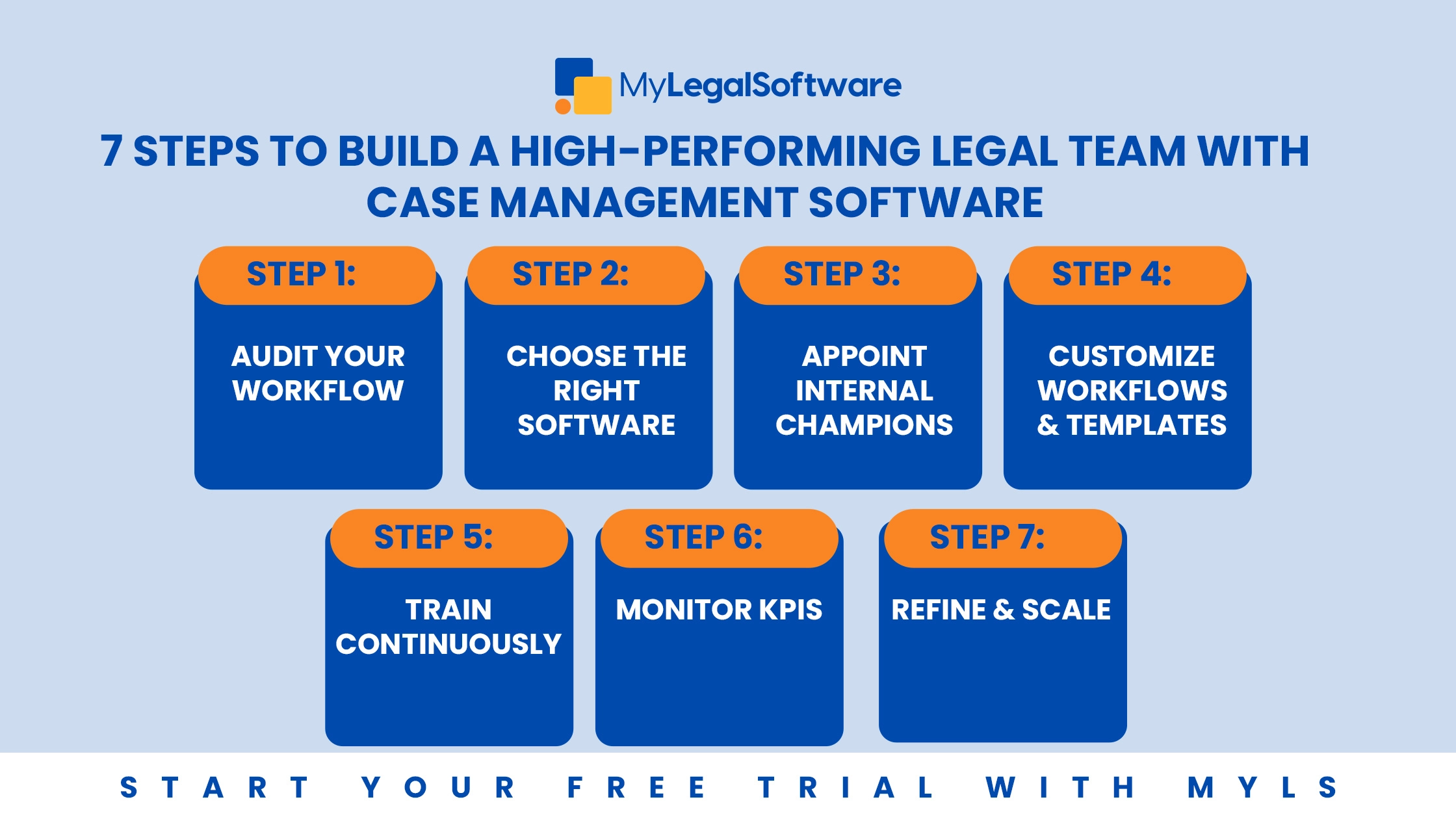In today’s fast-paced legal world, running a law firm takes more than legal expertise. You need smooth collaboration, timely communication, and efficient systems to keep up with rising client expectations. That’s where legal case management software comes in. It’s not just for organizing files—it’s a powerful tool for improving performance, boosting productivity, and staying compliant.
Whether you lead a small firm or a growing legal team, the right software helps you build a high-performing team—one that works with clarity, speed, and accountability. In this post, we’ll break down what makes a legal team thrive, how case management tools support that, and the steps you can take to unlock your firm’s full potential.
What Does a High-Performing Legal Team Look Like?
Before diving into how software can transform your law firm, it’s important to understand the core qualities of a high-performing legal team. It’s not just about working long hours or handling a large caseload, it’s about working smart, staying organized, and delivering consistent results without chaos behind the scenes.
Here are the key traits of a truly effective legal team:
- Clear communication among team members and with clients
- Defined roles and responsibilities across departments and practice areas
- Efficient task management with built-in systems for accountability
- Centralized access to information so nothing falls through the cracks
- Proactive use of data and performance metrics to guide decisions and improve operations
When these elements are missing, even the most skilled professionals struggle. You’ll start to see duplicated efforts, missed deadlines, delayed filings, unhappy clients, and eventually, team burnout and staff turnover.
This is where legal case management software becomes essential. It gives your team the structure, visibility, and tools they need to collaborate better, work more efficiently, and stay focused on delivering excellent legal outcomes. It’s not just a tech upgrade; it’s a performance strategy.
How Can Case Management Software Improve Legal Team Productivity?
At its core, case management software offers law firms a centralized system for managing client information, documents, deadlines, billing, and communication. But beyond the basics, it becomes a powerful tool for enhancing team efficiency, visibility, and collaboration.
Here’s how:
1. Centralized Case Access
With cloud-based access, teams no longer waste time chasing documents or status updates. Everyone stays on the same page—literally and figuratively.
2. Automated Task Assignment
Set recurring tasks, assign deadlines, and track progress in real-time. This helps legal teams move from reactive to proactive.
3. Built-In Communication Tools
Many platforms include secure internal messaging and client portals. These improve both client satisfaction and internal team coordination.
4. Time Tracking & Billing Integration
No more lost billable hours. Time entries can be linked to specific tasks and cases, reducing errors and improving profitability.
5. Analytics for Performance Insights
Use dashboard reports to identify bottlenecks, track case duration, and improve forecasting—key ingredients for a high-performing team.
Why Do Law Firms Need Case Management Software?
Clients want fast updates and clear communication. Your legal team needs less admin work and better tools to stay productive. Without the right system, meeting both needs can be a struggle.
That’s why case management software is now essential, not optional. It helps law firms deliver better service while keeping operations smooth and efficient.
Here’s what you gain with the right software:
- Fewer administrative errors
- Faster case turnaround times
- Improved client communication
- Higher staff satisfaction and lower turnover
- More accurate billing and reporting
When implemented thoughtfully, legal workflow automation becomes more than just a digital upgrade; it becomes a competitive edge. It helps your firm stay agile, client-focused, and growth-ready in a legal landscape that demands nothing less.
What Features Make Legal Software Ideal for High-Performing Teams?

Choosing the right case management software can make or break your firm’s efficiency and team performance. That is why it is important to look out for these features when choosing a case management tool for your law firm:
- Document & email integration
- Task tracking & calendar sync
- Custom workflows and templates
- Role-based permissions & access control
- Client communication portals
- Real-time team collaboration
- KPI and reporting dashboards
- Secure cloud-based access
- Integration with billing, accounting, and e-signature tools
A tool like MyLegalSoftware offers many of these features—so if you are to make a decision, your choice should depend on your firm’s size, goals, and practice areas, and the MyLS consultation can help make the best decision for your legal firm.
How to Build a High-Performing Legal Team with Case Management Software: A Step-by-Step Plan
To see real transformation, you’ll need more than just a software subscription. You need a strategic rollout plan that supports change management, upskilling, and cultural alignment.

Step 1: Audit Your Firm’s Current Workflows
Start by assessing how your team currently operates. Look for signs of inefficiency like missed deadlines, siloed communication, manual data entry, and duplicated work. This audit will help you pinpoint exactly where software can add the most value.
Step 2: Choose the Right Software
Not every case management tool fits every firm. Focus on the features that address your specific pain points, like time tracking, task automation, or client communication tools. Avoid shiny tools that don’t serve your goals.
Step 3: Create Internal Champions
Select one or two team members to become “power users.” These internal champions should master the software early, help with team training, and offer peer-to-peer support during the transition. They also help minimize resistance to change.
Step 4: Customize Workflows & Templates
Don’t settle for default settings. Tailor task workflows, document templates, and user roles to match your firm’s unique processes and practice areas. This makes the software feel intuitive and relevant from day one.
Step 5: Train Continuously
Initial training is essential, but so is ongoing learning. Offer onboarding walkthroughs, quick how-to guides, and refresher sessions to keep everyone up to speed and using the software to its full potential.
Step 6: Monitor KPIs
Track performance metrics such as on-time task completion, client communication response times, billable hour accuracy, and software usage. These KPIs help you evaluate the system’s impact and uncover areas for improvement.
Step 7: Refine and Scale
Gather team feedback regularly and refine your workflows based on what’s working (and what’s not). Once your team is comfortable, begin introducing more advanced features like integrations with billing tools, e-signature platforms, or AI-powered insights.
By following this roadmap, law firms can turn case management software into a powerful performance engine, boosting efficiency, reducing burnout, and creating a culture of accountability and growth.
Measuring Team Performance in a Law Firm with Software
Once your case management system is fully implemented, tracking your legal team’s performance becomes far more efficient—and far less manual. The right legal case management software provides built-in dashboards and automated reports that give you real-time insights without the need for spreadsheets or complex data entry.
Here are key performance metrics every law firm should monitor:
- Percentage of tasks completed before the deadline: This shows how effectively your team is managing time and priorities. A high on-time completion rate often reflects strong collaboration and proper workload distribution.
- Hours billed vs. hours worked: Tracking billable utilization rates ensures that your team’s efforts translate into revenue. It also highlights areas where non-billable tasks may be draining valuable time.
- Number of cases managed per attorney or paralegal: This gives insight into productivity and helps identify if someone is over- or underutilized within your legal operations.
- Client satisfaction scores and response times: Use post-case surveys and communication logs to measure client experience—an increasingly important KPI in today’s competitive legal market.
- Employee workload balance and turnover rates: Monitoring these metrics helps prevent burnout and improve retention, both of which are vital for building and maintaining a high-performing legal team.
Modern law firm software solutions like MyLegalSoftware often come with customizable KPI dashboards, allowing firm leaders to analyze performance at a glance. With the ability to filter by department, practice area, or individual user, you can make informed decisions that improve both productivity and team satisfaction.
FAQs
-
What are the best legal case management tools for small law firms?
-
Can cloud-based case management improve remote legal team productivity?
-
How do I choose the right legal software for my team?
MyLegalSoftware, Clio, Rocket Matter, and MyCase are popular with small to mid-sized law firms due to their affordability and intuitive interfaces.
Yes. It ensures team members can access case files, update notes, and communicate in real time from anywhere.
Focus on your current pain points, then compare software features, support options, scalability, and reviews.
Final Thoughts: Technology + Teamwork = Success
Building a high-performing legal team isn’t about working harder; it’s about working smarter. When used strategically, case management software becomes more than a digital tool; it’s a driver of clarity, efficiency, and consistent results.
MyLegalSoftware offers many of the core features today’s firms need—streamlined workflows, secure client portals, billing automation, and performance tracking, all designed to reduce admin burden and boost collaboration.
If your firm is facing inefficiency or burnout, try MyLegalSoftware with a 14 day free trial or book a personalized demo to see how automated workflows, secure portals, and real-time insights can transform your legal team.








